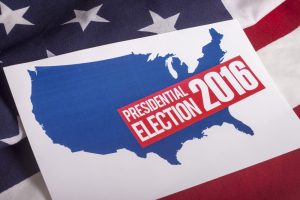
Programmatic Meets Politics in the 2016 Presidential Campaigns
Programmatic
Jan 04
 Advertising spending by both major political parties in the United States has skyrocketed in 2016. Because of the unpredictable nature of this year’s presidential race, both parties are pouring more money into major media advertising on radio, cable TV/network TV, and online/digital offerings.
Advertising spending by both major political parties in the United States has skyrocketed in 2016. Because of the unpredictable nature of this year’s presidential race, both parties are pouring more money into major media advertising on radio, cable TV/network TV, and online/digital offerings.
Research firm Borrell Associates estimates that the combined parties will spend $11.7 billion. TV spending will make up a majority of that number, coming in at around $6 billion. Cable TV was next highest, with $1.7 billion expected, and online and digital spending was expected to increase 8.2% to about $1.165 billion. Radio spending was expected to jump to $916 million, according to the report. The projections rose in recent months, as Borrell explained, due to the “intensity of the political scene thus far, and the likelihood of the drama playing out for the remainder of the year.”
What does this mean for pure programmatic advertising? Defined broadly as automated, targeted advertising bought on real-time bidding platforms, programmatic advertising spending by both Democratic and Republican parties will exceed $1 billion in this year’s campaign. By comparison, the digital advertising spend during the 2012 election season accounted for only $160 million, per eMarketer.
BuzzFeed Turns Down the Donald
Adding to the unpredictable nature of this year’s presidential campaign, a major online publisher walked away from a million dollar programmatic ad deal.
Online publisher BuzzFeed announced that it pulled out of a $1.3 million advertising deal for programmatic advertising from the Republican National Committee and its attendant ads for Donald Trump, the GOP’s presumptive presidential candidate. BuzzFeed declined the deal, according to Business Insider, primarily due to its staff’s objections to working on ads for the Republican National Committee.
Instead of just accepting a client’s pre-made digital ads, BuzzFeed staffers work to create original content in the form of videos, quizzes, infographics, games and more. And after internal discussion, BuzzFeed executives decided it would cause more harm to its staff than good if it accepted the deal to work on the ads.
BuzzFeed cited its choice to turn down the Trump ads as a move to protect its employees from “…promoting things that limit our freedom and make it harder for them to live their lives.” In essence, BuzzFeed CEO Jonah Peretti declined the deal because of Trump’s fiery positions and statements regarding Muslims, women’s rights, immigration, and the role of news media in American life. As Peretti noted in a company-wide email: “We certainly don’t like to turn away revenue that funds all the important work we do across the company. However, in some cases we must make business exceptions: we don’t run cigarette ads because they are hazardous to our health, and we won’t accept Trump ads for the exact same reason.”
Highest Campaign Spend in 2012
Earlier in the 2010s, particularly during the 2012 and 2014 political cycles, Republican and Democratic candidates alike were spending millions of dollars on campaign advertising across all platforms. By targeting specific web-centric audiences and demographics, campaign staffers were better able to automate media buyers’ purchase processes. They used real-time bidding and data intelligence for web display ads, social media ads, online video campaigns, and mobile targeting.
This New York Times chart of 2012 campaign spending shows that the Democratic and Republican parties each spent nearly $1 billion of campaign money in support of their candidates. The amount spent directly on television ads isn’t clear, but it was record breaking. The 2012 presidential campaign was deemed to be the most expensive election in history from a campaign spend perspective.
Mitt Romney’s 2012 presidential campaign, for instance, moved away from traditional televised options and spent tens of millions of dollars on political programmatic advertising for the web, according to one of Romney’s former staffers. Much of the success of Romney’s political programmatic ads was due to the processes installed by digital marketer Zac Moffatt, who has since gone on to start his on digital data firm.
Most of Trump’s media exposure has come from his calling into TV programs for interviews, rather than sitting in a studio. He also helps manipulate controversies from his personal Twitter account. Trump’s tweets are posted to counteract, buffer, or spread the day’s news. In taking this route, and bypassing major media ad spend, Trump has fundamentally altered the future landscape of political advertising.
2016 and Beyond
This year’s presidential election cycle was initially thought to be more of the same, but it’s appearing far different than previous campaigns. Television advertising still matters in this campaign – eMarketer cited a Nomura Securities study that showed that television still makes up the largest share of political ad spending, amounting to some $6 billion.
There will certainly be more push and pull between advertisers and publishers, and there will be change and speculation regarding how campaigns spend marketing dollars in regards to programmatic advertising. However, the bigger story is still emerging. This story focuses on how internet social platforms like Facebook, Twitter, and Snapchat are rerouting the power of media distribution away from traditional publishers by curating news on their own platforms that have an extensive reach and an immense audience base. Where will that leave traditional publishers and their pursuit of political advertising dollars in the coming years?
Learn more about Programmatic and it’s results here.





